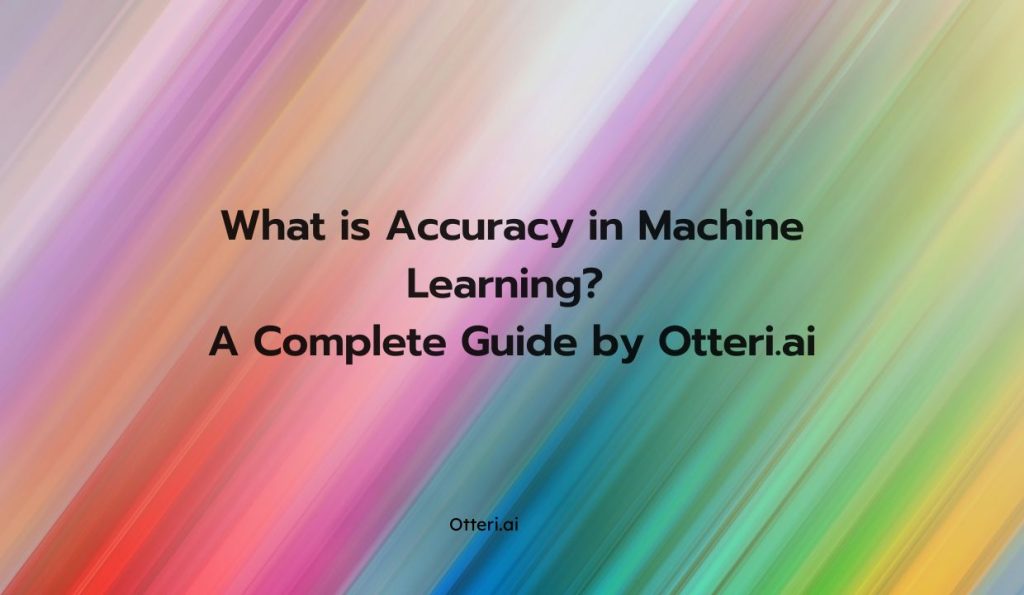
What accuracy means in machine learning, how it’s calculated, why it matters, and when it’s not enough. Learn with real-world examples in this guide from Otteri.ai.As businesses and industries rapidly adopt artificial intelligence and machine learning to automate decisions and gain insights, it’s important to evaluate how well these models perform. One of the most commonly used performance metrics is accuracy. But while accuracy is widely cited, it doesn’t always tell the full story. In this blog post, we’ll break down what accuracy in machine learning really means, how it’s calculated, where it excels, and when it’s not the right metric to use.
Understanding Accuracy: The Basics
In simple terms, accuracy is the ratio of correct predictions to the total number of predictions made by a model.
Types of Predictions in Machine Learning
To get a deeper grasp of accuracy, it helps to understand how predictions are categorized. In a binary classification problem, outcomes are typically labeled as positive or negative. The predictions fall into one of four categories:
True Positive (TP): The model correctly predicted the positive class.
True Negative (TN): The model correctly predicted the negative class.
False Positive (FP): The model incorrectly predicted the positive class.
False Negative (FN): The model incorrectly predicted the negative class.
When is Accuracy Useful?
Accuracy is a reliable metric when:
The dataset has a balanced distribution of classes.
The cost of misclassification is similar across classes.
You want a quick overview of model performance.
For instance, in spam detection where spam and non-spam emails are roughly equal in number, accuracy can give a fair estimate of model effectiveness.
At Otteri.ai, we often use accuracy to evaluate initial model drafts before diving into more nuanced metrics.
The Limitations of Accuracy
Accuracy can be misleading, especially in datasets with imbalanced classes. Consider a medical test for a rare disease that occurs in only 1% of the population. A model that always predicts “no disease” would still have 99% accuracy—but it would be useless for detecting the disease.
That’s where other metrics come into play:
Precision: How many of the predicted positives are actually positive?
Recall (Sensitivity): How many actual positives were correctly predicted?
F1 Score: A harmonic mean of precision and recall.
In applications like fraud detection or medical diagnosis, Otteri.ai recommends using a combination of these metrics rather than relying on accuracy alone.
Accuracy in Multi-Class Classification
Machine learning models often deal with more than two classes—called multi-class classification. Accuracy is still calculated the same way: the proportion of correct predictions across all classes.
For example, if your model classifies emails into “Promotions,” “Social,” and “Updates,” and correctly classifies 850 out of 1,000 emails, the accuracy is 85%.
However, if one class dominates the dataset, high accuracy may still mask poor performance on minority classes. That’s why Otteri.ai supports confusion matrices and per-class metrics to give you a clearer picture.
Measuring Accuracy in Real Projects
In a typical Otteri.ai project, here’s how accuracy is used:
Initial Benchmarking: After training, we check the model’s overall accuracy to gauge performance.
Validation: We use a separate validation dataset to measure accuracy and avoid overfitting.
Testing and Comparison: Models are compared based on accuracy along with precision, recall, and F1 score.
Deployment Monitoring: Once deployed, we continuously monitor accuracy to detect model drift or performance degradation over time.
This holistic approach ensures the model not only works in theory but also performs well in the real world.
How to Improve Accuracy
If your model’s accuracy is low, here are some strategies:
Clean and label data accurately: Garbage in, garbage out. Otteri.ai’s labeling tools ensure your data is high quality.
Use feature engineering: Extracting meaningful features can significantly boost model performance.
Try different algorithms: Sometimes, a different model architecture or ensemble method works better.
Tune hyperparameters: Use techniques like grid search or random search for optimal model settings.
Balance the dataset: Use oversampling or undersampling to even out class distributions.
Otteri.ai offers tools and services to support every step in this process, from dataset preparation to model tuning.
Accuracy vs. Business Goals
At Otteri.ai, we often ask: Does accuracy align with your business objectives? A model with 95% accuracy might still be unusable if it fails in the 5% of critical cases.
Instead of aiming for “perfect” accuracy, businesses should define acceptable thresholds based on the cost of errors, user experience, and regulatory impact.
For example:
In e-commerce, a recommendation engine might tolerate lower accuracy if it drives more engagement.
In healthcare, even a small misclassification can have serious consequences—requiring higher standards and alternative metrics.
Conclusion
Accuracy is a powerful and widely understood performance metric in machine learning, offering a quick snapshot of model effectiveness. However, it’s not always the best or only metric to use—especially in high-stakes or imbalanced scenarios.
At Otteri.ai, we believe in a data-first, metric-smart approach. By understanding when to use accuracy—and when to go beyond it—you can make smarter decisions, build better models, and deliver more reliable AI solutions.
Call to Action
Want to build smarter AI models with meaningful metrics and accurate results? Try Otteri.ai today to streamline your machine learning workflow—from data labeling to model evaluation.